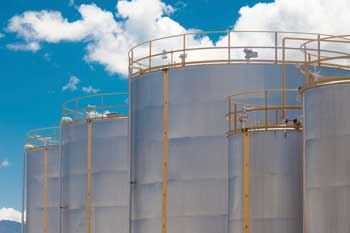| Jan 24, 2018 |
Calculating the CO2 emissions of biofuels is not enough
|
|
(Nanowerk News) A new EU regulation aims to shrink the environmental footprint of biofuels starting in 2021. But an EPFL scientist thinks we should go one step further and take into account all compounds produced at biorefineries, not just biofuel. And he has developed a model for doing just that.
|
|
“In my study, I wanted to show that calculating the greenhouse gas emissions of biofuels tells just half of the story. What we really need to do is quantify the emissions of each product coming out of biorefineries,” says Edgard Gnansounou, professor at EPFL and head of the school’s Bioenergy and Energy Planning Research Group.
|
|
To that end, Gnansounou has developed a sophisticated computer model described in an article appearing in Bioresource Technology ("Coproducts performances in biorefineries: Development of Claiming-Based Allocation models for Environmental policy").
|
 |
| Tanks storing vegetable oil.
|
|
Biofuels and other biomass-derived products have become viable options for replacing fossil fuels. But they have to meet certain environmental standards if they are to genuinely help cut carbon emissions. Under a new EU directive, bioethanol-based fuels – which are made by fermenting biomass – must save 70% greenhouse gas emissions compared to their fossil-fuel counterparts starting in 2021. |
|
In Switzerland, the government passed a law requiring that from 1 August 2016, biofuels must cut greenhouse gas emissions by at least 40% relative to fossil-fuel equivalents. However, calculating the total greenhouse gas emissions of biofuels is no mean feat.
|
|
The entire processing chain – not just the production of the biofuel itself – must be taken into account. For sugar cane, that would include emissions from growing and harvesting the plant, transporting it to a biorefinery, turning it into biofuel, and producing the other compounds and animals feed supplements that are generally made as coproducts. The hitch is that until now, no computer model existed for analyzing the entire life cycle of each product and coming up with a single emissions figure subject to environmental requirements.
|
|
One major challenge is the many different variables involved in calculating the emissions of biofuels and their various coproducts. But after five years of research, Gnansounou has come up with a model that incorporates all the various data.
|
|
“I tackled the problem of allocating greenhouse gas emissions among the different coproducts by specifying an environmental requirement for each one. That lets plant engineers compare those emissions with their fossil-fuel equivalents and set up the right incentives to make their biorefineries economically viable.”
|
|
Gnansounou’s model is intended for second-generation biorefineries, which are still relatively new – only five currently exist around the world. The advantage of these biorefineries is that instead of processing crops that are also used as food, they use debris from farming (like wheat straw) and foresting. Wheat straw is the crop that Gnansounou looked at specifically, taking into account the wheat ears, which are used for food, and the stems, which are used by biorefineries to produce bioethanol for fuel, biogas for heating and electricity and phenol for the chemical industry.
|
|
He also factored emissions from the fertilizer and farming machines used to grow and harvest the wheat, and whether the field had previously been used for other crops. Once he calculated a total greenhouse gas emissions figure, he used his model to divide the total up among the various coproducts.
|
|
With his research, Gnansounou hopes to bring a scientific perspective to the political and economic debate on biofuels.
|
|
“Second-generation biorefineries should replace some oil refineries, but engineers still don’t have a clear method for calculating emissions across a biofuel’s life cycle,” he says. “What’s more, biorefineries have trouble competing with low oil prices” – since biofuels are two to three times more expensive than fossil fuels.
|
|
He concludes: “Policymakers still haven’t fully grasped the emissions challenge, which is why it’s a good area for research.”
|
|
Gnansounou believes that the renewable energy industry is too focused on the greenhouse gas emissions of biofuels alone, whereas it should be looking more closely at the emissions of each coproduct from biorefineries, subject to climate policy constraints. That would also give consumers more information about the sustainability of biomass-derived products. Gnansounou plans to continue his research on other types of crops and publish his findings in a second article.
|

